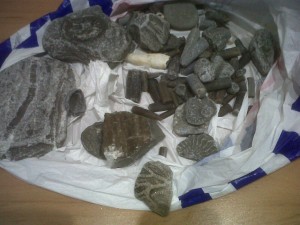It’s a mountain of mud, Black Ven, constantly flowing and collapsing and being washed into the sea. It’s the largest mud slide in Europe. On one end, at a place called Church Cliffs, Mary Anning found her famous ichthyosaur fossil in 1811. It’s impossible to stand on the beach looking up at its towering black mass and not be a little bit weak-kneed.

The cool thing about Black Ven is that it’s not JUST a mountain of mud. Black Ven is a mountain of prehistoric mud, a mountain of mud filled with fossils. Raymond and I walk along the beach with the other fossil hunters beneath this intimidating wall of mud hoping we’ll get lucky and find something positively Jurassic.
Bright yellow signs warn fossil hunters to keep off the unstable mud cliffs, and even from a safe distance, occasionally we can feel the mud shifting beneath the sand and rock. Just a reminder that this is a landscape in flux.
We’re on holiday in Lyme Regis. We have our official goggles to protect our eyes from flying rock fragments, and we have our official hammers and chisels to create said flying fragments in search of the surprise in the middle. I keep my focus on the litter and debris under my feet, not just looking for fossilised treasure, but also to keep from falling on my butt.

The best find of the day is an exquisitely detailed crinoid Raymond finds while standing a little bit closer to the threatening mud mountain that I’m particularly comfortable with. But then after he finds it, I’m willing to risk a closer walk. A bloke from Brazil is there with his wife. He

points us to a right smorgasbord of belemnites closer. It’s like picking up small bits of pointed rock bullets, and the more we pick up, the more we want to pick up – even while we’re wondering what we’re going to do with a pocketful of belemnite bits.
A lot of the bigger rocks, the boulders too big to stick in our pockets and bring home are covered in trace fossils of

ammonites. We take snapshots to remember how amazing they are, and we stand for a long time admiring their beauty and their size. While we eat our sandwiches looking out to the changeable sea, Raymond reads to me from the fossil book that some ammonites got to be two meters across. I’m stunned. He reads the name from the book –Titanites giganteus, which we both agree is a good name. Most died out before the Cretaceous, he adds.
As the tide begins to come in, we work our way back toward Lyme Regis and end up in the Pilot Boat Pub for a pint and some chips – our reward for the successes of the day. It’s supposed to rain tomorrow, and we’re told the worse the weather the more fossils wash out of Black Ven.
Now back home in our cottage, as we look over our stash and sip coffee, we talk about

what a perfect day it’s been, eagerly looking at other fossil hunters’ treasures and sharing our own, sifting through the rock that’s been washed from Black Ven by the sea and the rains, and experiencing the rush of finding bits of the ancient past before they wash out to sea and are lost forever. It was a good day. It’s supposed to rain tonight. Who knows what treasures will wash free from the prehistoric mud? Someday the whole mountain will wash into the sea, along with all of its secrets of the past. But as for today, we took home a few of those fabulously ancient secrets tucked away in the pockets of our walking trousers.
Some experiences have nothing to do with writing, and everything to do with widening and deepening my inner world so that I have something to write about. Finding Jurassic treasures that Black Ven has given up to the sea is one of those experiences.
Sounds like you’re having a wonderful time! Love fossil hunting! I can’t wait to see you tomorrow. xx
It’s been great fun, Hon! Found some lovely ones today. Can’t wait to see you either!
Kx